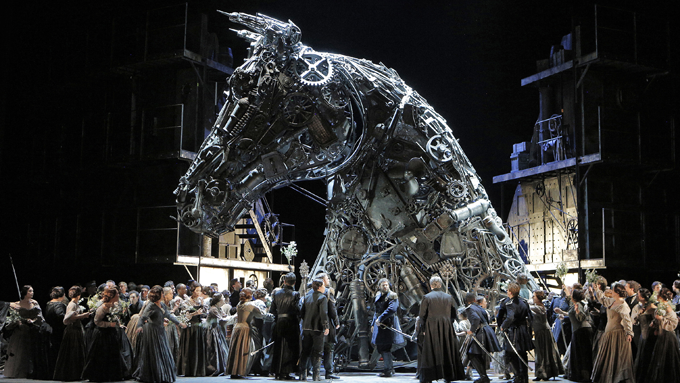
BLOCKBUSTER ‘TROYENS’ RUMBLES THROUGH SAN FRANCISCO
Two Operas in One, Studded with Choruses and Ballets, Plus a Prime Diva
SAN FRANCISCO—A vast French-romantic creation, as only Berlioz could conceive it, has taken over the S.F. Opera stage and in effect thrown down the glove, challenging other troupes to match or do better, while challenging the endurance of both performers and audience. It adds up to five hours, five acts, and more savory choruses and ballet segments than in a month of run-days.
After a low-key start, Berlioz’ “Les Troyens” (The Trojans) catches fire musically and dramatically for an overwhelming finish. The grand opera breaks down into two distinct parts. Call it Troy and Carthage. Or, Cassandra and Dido, the two successive leading ladies. Or, tragedy and love story.
Berlioz spent two years creating the libretto and music for his Aenead-laced magnum opus, a unique French counterpoise to Wagnerian opera (and, in retrospect, arguably to “Tristan und Isolde.”) Above all, this is the up-and-down story of Carthaginian Queen Dido, her love for Aeneas, her disillusionment and resultant suicide on the pyre. Silver-voiced mezzo Susan Graham, a true actress-singer, carried this off magnificently with the S.F. Opera when heard June 12. She brought to bear ever greater power as the night went on, finally bending the pitches deliberately in her fury over her beloved Aeneas’ abandonment. Her long aggrieved solo scena precedes her funeral-pyre death scene with chorus, beautifully played out.
This blockbuster co-production benefited greatly from an exciting new tenor, Bryan Hymel. His supple voice, strength and discipline added up to a real find. He was an effective partner for diva Graham, though not convincing in wanting to abandon his Dido in favor of founding Rome. (Blame it on badgering by the gods!)
In the shorter and far more tragic Troy segment, the oracle Cassandra played by dramatic mezzo Michaela Martens was more notable for vocal wattage than stage manner.
The rest of the inordinately large cast—30 in all—was the usual mix of bouquets and bluster. Capping the ensemble was yet another mezzo, Sasha Cooke, playing Dido’s companion Anna with an endearing voice and good stage presence.
The steely David McVicar production was a blockbuster, bigger than life, dominated by a four-story structure that split open to show the Trojan horse: A fiery mechanical horse-head a mere three stories high, later giving way to an immense Terminator humanoid. This fit in with the production update to the Industrial Revolution, the costumes suggesting the Crimean War (shortly before our Civil-War era).
The orchestra under the gifted left-handed conductor Donald Runnicles was everywhere, in the pit, backstage and on high, consistent with Berlioz’s gargantuan musical demands. And it got deserved ovations. The long and fetching clarinet solo for Andromache’s scenelet was carried off gorgeously by the principal, Jose Gonzalez Granero.
The musical highlights went beyond the cornucopia of solo voices and choruses. Particularly deft were the beloved Trojan March and the Royal Hunt music. The latter featured animated hunt scenes in dance, with men playing the snarling, charging dogs on leashes in memorable fashion.
If there was more dance than normal for French romantic opera, it was well conceived and well executed by close to a dozen performers. Are we now emphatically past the era of opera ballets being the dregs of the dance world?
Many of these segments could be excised, given their limited dramatic relevance and the great length of the work. At the core, this double opera is vital, even riveting, and at least one of the performances sold out.. But the non-dramatic elements weigh down “Les Troyens” and slow the action. In addition, the production costs entailing these large forces can quickly turn astronomical, with costly overtime pay assured this time for the orchestra, among others. Little wonder that when the S.F. Opera gave the piece its professional US premiere in 1966-69, the score was heavily trimmed by two hours, as part of the lean-and-mean conciseness favored by double-diva Regine Crespin, playing both Cassandra and Dido each night. The SFO never presented it again until these performances.
This show is a co-production with three major European houses.
Berlioz’s opera “Les Troyens,” in French, at the S.F. Opera, running through July 3. Five hours, two intermissions. For info: (415) 864-3330, or go online.
©Paul Hertelendy 2015
#
Paul Hertelendy has been covering the dance and modern-music scene in the San Francisco Bay Area with relish — and a certain amount of salsa — for years.
These critiques appearing weekly (or sometimes semi-weekly, but never weakly) will focus on dance and new musical creativity in performance, with forays into books (by authors of the region), theater and recordings by local artists as well.
#